Urwerk EMC Pistol, the horological exception
The EMC watch, constructed by the URWERK company, is a milestone in luxury watchmaking as the first and only mechanical watch in which the rate can be checked electronically at any time simply by pressing a button.
The originality and ingenuity of the EMC concept have been widely acclaimed. The 2014 Geneva Grand Prix d’Horlogerie awarded the EMC two first prizes in the “exceptional mechanism” and the “innovation” categories, while the watch earned Felix Baumgartner the title of Watchmaker of the Year in Hong Kong. Just as important for the URWERK team are the plaudits received for the EMC from Mr Philippe Dufour, the recognised virtuoso of high-grade watchmaking.
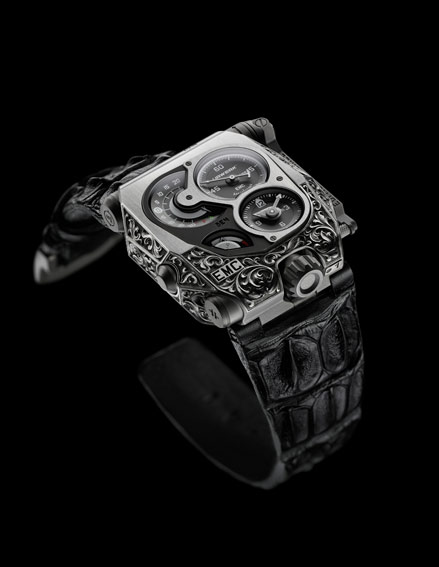
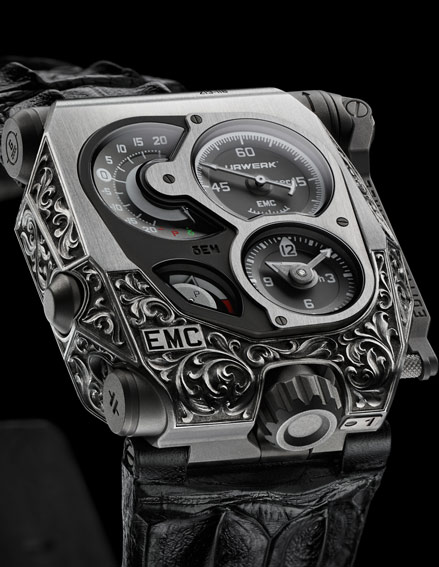
For this last version of the EMC – the Pistol – URWERK has brought together the leading craftsmen and the most skilled hands to do justice to these five unique watches. Florian Güllert was responsible for the engraving, Joséphine and Sylviane took care of the leather work for the strap while URWERK’s artistic director, Martin Frei, and master-watchmaker, Felix Baumgartner, have unstintingly given of their best to create this watch. The EMC Pistol is the fruit of this exceptional alliance. Introductions.
Florian Güllert
The first thing you notice when you meet Florian Güllert are his hands – large, thin and well manicured hands.
Florian Güllert specialises in engraving firearms. He is a painstaking worker who loves his craft, proving that enthusiasm can coexist with meticulous care. For 15 years he has demonstrated his talent by transforming shotguns and handguns into works of art. Freehand chasing and engraving leave his mark on metal in scrolls and letters. “Engraving is a way of capturing light,” he explains “It bares the metal and creates zones of shade. The metal is forcibly worked and astonishingly that is what makes it beautiful.”
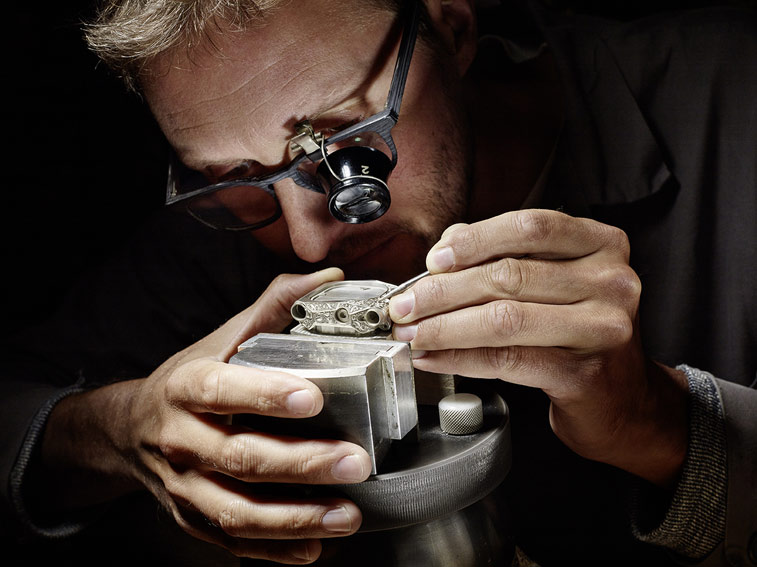
This 43-year-old master-engraver set up his workshops at Klagenfurt on the shores of the Wörthersee lake in Austria. He started his career as a gunsmith, graduating in 1995 from the Ferlach technical college. But he soon changed track. It was no longer the guns themselves that obsessed him; they merely became the canvas for his art. “You can compare engraving on metal with calligraphy, while hammer peening creates such subtle nuances that they cannot be reproduced exactly. Each mark you make is unique and definitive. That is the beauty of craftsmanship,” he confides.
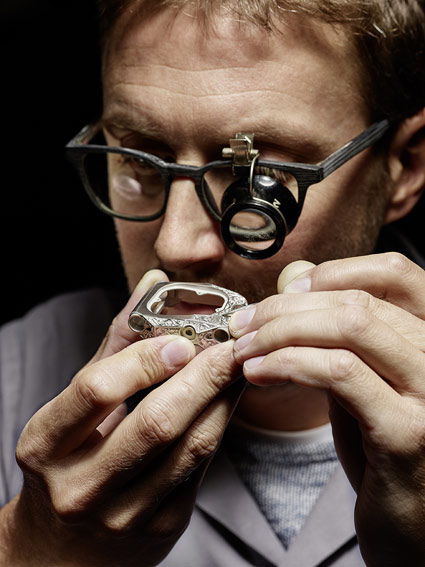
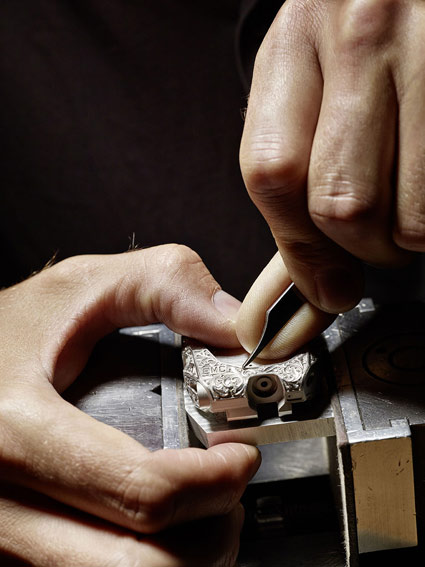
Four or five years ago, one of his clients mentioned URWERK. Curiosity led him to the website. When the watch company contacted him in 2014, he immediately agreed to accept a commission. His only reservation was time; his order book was full and his agenda overloaded. But the desire remained. He received the blueprints of the EMC case and started his research. “I had to find a pattern that contrasted with the very mechanical and technical aspects of the object. I was looking for scrolls and arabesques that would break up the rectilinear architecture of the EMC. It was a rather unusual job for me, because the surface that you can decorate on a watch is restricted. You have to get it right and find a pattern that can be appreciated with an unaided eye.” There was another difficulty: the steel used in the EMC case turned out to be so hard that special tools had to be found. “But the method doesn’t change,” he concludes. “The actions of my hands are the same as those of all engravers throughout the ages. This is what we have in common with fine watchmaking: tradition is at the centre of our craft.”
Martin Frei
Martin Frei’s mother introduced him to world of art and his father, an astrophysicist, turned his gaze towards the stars. Today he’s the artistic director of URWERK, the watchmaking company that he co-founded.
Martin Frei constructs watches on paper, painting them in gouache before they assume their mechanical shape. “What I enjoy about our working sessions at URWERK is listening to Felix and the R&D team solving the technical problems of a watch that only exists as a rough sketch,” he declares.
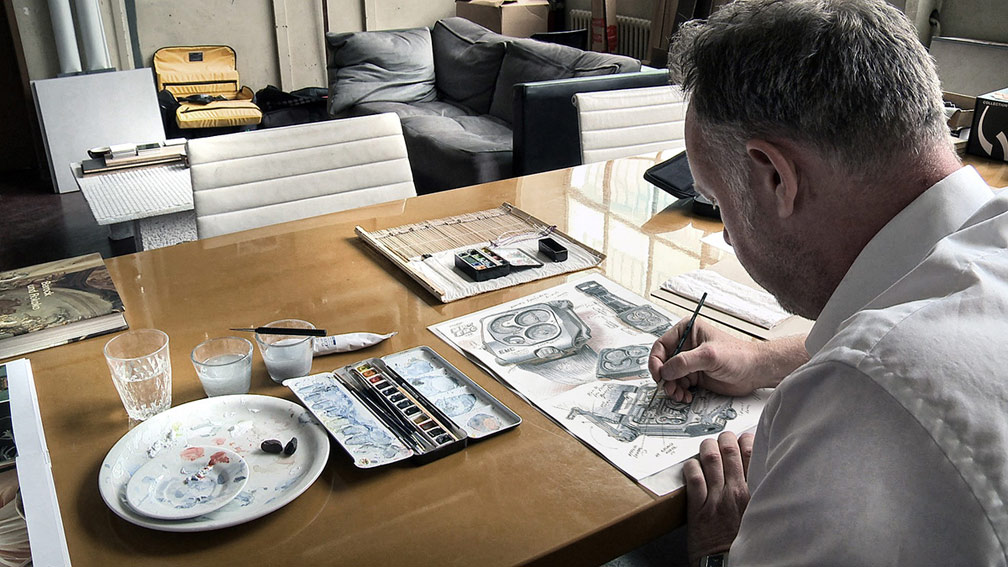
For the EMC Pistol, Martin Frei envisaged a watch that displayed contrasting styles. The minimalist design of the top part of the case dissolves into raised engravings. The smooth and satin-finished surfaces of the upper part highlight the decorative work of the lower section. “This abrupt change in style illustrates our intentions: we wanted an object that was both solid and fluid. Our EMC, which looks uncluttered, gains new strength from this almost baroque decoration. The engraving is similar to that on collectors’ firearms. It is sparing, it doesn’t dominate, yet it provides the final touch that creates surprise — the wow effect.”
The very distinct design of the EMC derives from the principle that form follows function. “The EMC is a mechanical watch fitted with a hand-cranked electric generator, a capacitor and a system that monitors its rate. It took me some time to combine all that into a watch that sits comfortably on the wrist. When we first demonstrated the EMC idea, the module was in its trial container — a plastic box 15cm long and 10cm wide and as thick as a brick. Miniaturising the components and maximising the space by making full use of every cubic millimetre was an exacting task that we undertook with pleasure. Every aspect of the EMC constitutes an exploit. Disguising the constraints and making it look easy is what we’re good at,” he concludes.
Joséphine Morf and Sylviane
Welcome to the little workshops of the Place Simon-Goulart in Geneva’s old watchmaking district of Saint Gervais. Hidden in an attic you find the Portalès leather company, presided over by its owner, Joséphine Morf, and Sylviane, her nimble-fingered worker.
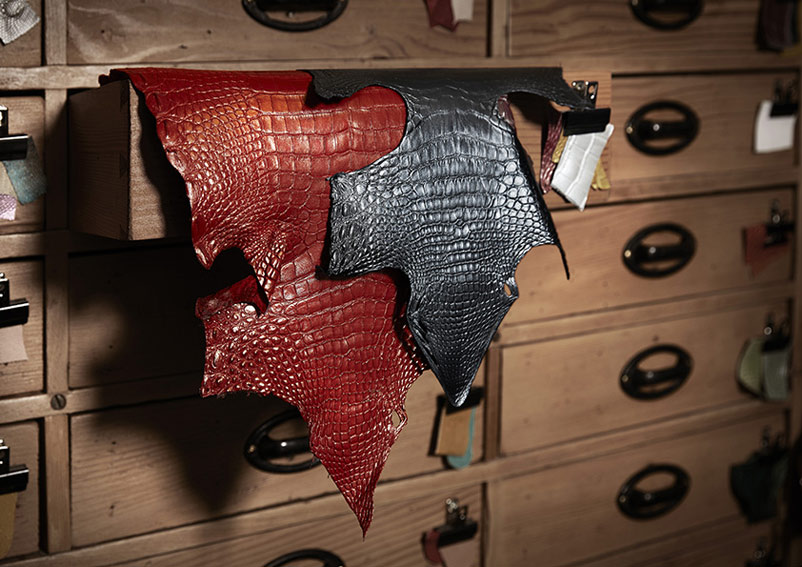
These two ladies are well known in watchmaking circles for their skill. Their speciality is the high-grade leather strap, the exceptional adjunct to outstanding watches.
“We make each item more or less on an individual basis and for very small series ordered by watchmakers and manufacturers of luxury leather goods,” Joséphine explains. “URWERK’s order at first took us by surprise,” she adds. “They wanted a part of the skin that we very seldom use because it is in relief. The straps we made are truly three dimensional with a series of small ridges.”
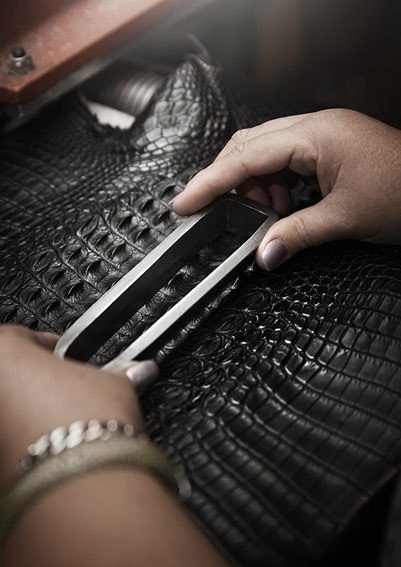
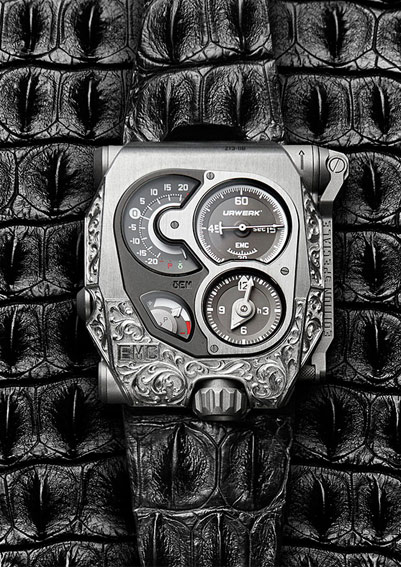
The strap for the EMC Pistol is certainly unconventional. Its manufacture is entirely in the hands of Sylviane who deftly manipulates edge bevellers, mechanical blades and cutters. “We have made five unique straps, which in my view are among the finest created by our company.”
Felix Baumgartner
Felix Baumgartner, the son and grandson of watchmakers, founded URWERK with Martin Frei and has presided over the fortunes of their company for the past 18 years. The EMC is his Holy Grail, his dream come true and the watch with which he renewed his skills and demonstrated that his commitment to fine watchmaking is as strong as ever.
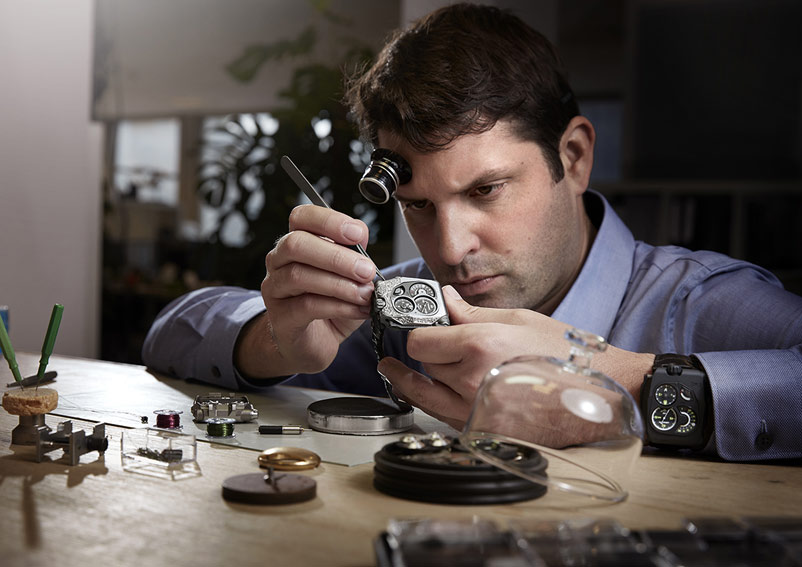
The EMC that he conceived is first of all based on URWERK’s proprietary movement — a chronometer movement with an original balance wheel and twin barrels. It’s also a crazy idea: an electronic device that oversees the proper operation of the watch by monitoring the sprung balance at its heart. The result is a mechanical timepiece that can be adjusted by its owner to achieve the best possible timekeeping performance. “Our aim was to give each EMC owner the information that hitherto could only be supplied by a watchmaker using sophisticated equipment. To achieve this we had to take a fresh look at the mechanism and redesign it from scratch to provide information that could be seen and analysed,” Felix Baumgartner explains.
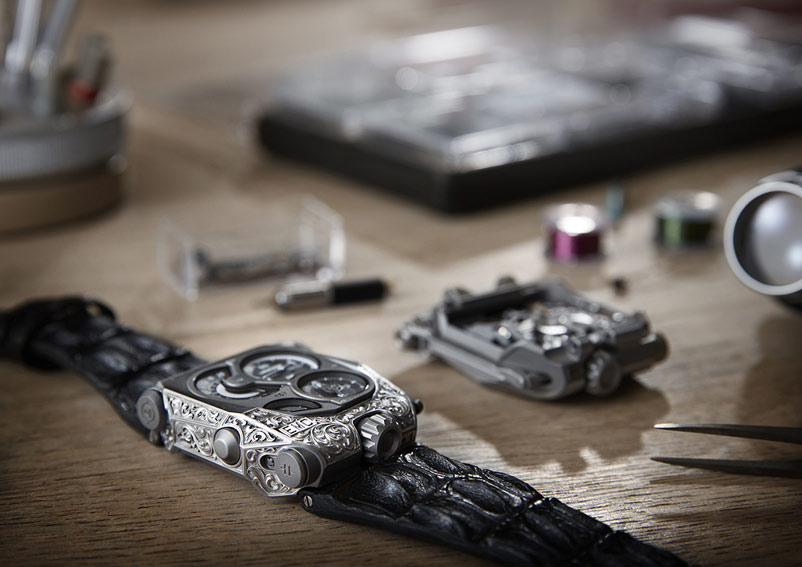
The movement for this watch was conceived, developed, manufactured and decorated in URWERK’s workshops. It’s a movement with a classic finish that contrasts with its futuristic performance. “We have finished it in the tradition of fine watchmaking, with Geneva stripes, snailing, shot-blasted and brushed finishes, because we have broken the rules elsewhere,” he declares. “One of the real joys of watchmaking is to enhance the material one works with,” he adds. “I started my apprenticeship at my father’s workbench where I stripped the dials and and wheels of old clocks. It was an endless task, but it made me proud. My father had an eagle eye that detected the smallest part that wasn’t up to standard. He gave me a sense of perfection.”